News for Autumn 2010
THE WHITE BOOK OF SOUTHWELL: Progress Report
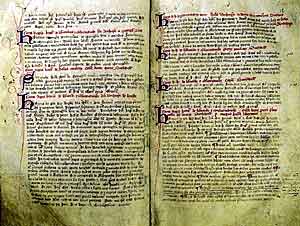
The White Book of Southwell.
Members will remember that a small committee has been formed to edit the White Book of Southwell. This is the main medieval cartulary (or register) of deeds relating to the Minster and its estates. It was known to Robert Thoroton and has been exploited by most subsequent generations of historians both national and local. Some contents have been published in their original language or in translation but no systemic edition has ever been undertaken. Mainly compiled between 1335 and the mid-fifteenth century, it currently consists of 476 pages and contains around 620 separate items, many of considerable length, the latest dating from 1610, though the vast majority concern the period c1180-1460. Beginning with papal bulls, royal and archiepiscopal charters granting various privileges to the canons (or prebendaries), the White Book supplies important evidence not simply for ecclesiastical history but for broader social and economic development in medieval Nottinghamshire. Whilst in addition to the 'historical' material, it furnishes a remarkable (and surprisingly little investigated) amount of linguistic evidence, personal, place, and field names, for instance.
Preliminary work to get a draft transcription in electronic form before more advanced editorial attention is given to individual items has recently made excellent progress. Currently around 95% of the text has been captured and the wide-ranging nature of the contents has been confirmed. Since full publication is still several years away, the Committee is happy to share this material with those interested in the history of individual parishes covered by the White Book, on the understanding that both text and commentary is still at a draft stage. Broadly speaking the area covered coincides with the 28 parishes which latterly formed the Peculiar of Southwell, bounded by the west bank of the Trent from Fiskerton and Rolleston to North Leverton and Eaton, and the eastern edge of Sherwood Forest from Oxton and Blidworth northwards, with rich documentation for town life at Southwell itself. Anyone wishing to use this material should contact Professor Michael Jones (mcejones@btinternet.com).
See picture on back page, the caption for which is: The earliest document copied into the White Book: a notification by Henry I to the sheriffs of Nottingham and barons of Nottinghamshire and Derbyshire that he has confirmed to Archbishop Thomas of York all his customs over his lands, especially those of the church of Southwell, and ordering justice to be administered in accordance with the right of the canons of St. Peter's [York], Nottingham [?17 October 1109].
Michael Jones
CRESSWELL CRAGS
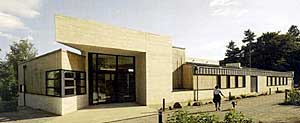
The New Visitor Centre at Cresswell Crags.
Cresswell Crags ambition and hard work has been recognised in the 2010 Derbyshire Heritage awards having been named as Museum of the Year.
The new visitor centre [pictured on the back page] was amongst six contemporary buildings from across the East Midlands to be short listed for a RIBA award in the nation's top competition for architecture. OMI Architects were also nominated for The Bridge of Discovery for Cresswell Crags Museum & Heritage Centre and both projects were runners-up in their categories.
The landmark new exhibition Great Excavations opened to the public on 12 June 2010 and charts the history of archaeological investigation over the past 200 years in one of Cresswell Crags most celebrated caves, Church Hole. This cave houses the only known Ice Age art in Britain. First excavated in 1876 the cave and its artefacts gave an insight into the prehistoric tribes sheltering there thousands of years ago. Re-excavations in 2006 by Sheffield University of the Victorian excavation's debris have shed light on the thoughts and processes of the people who explored the cave over 200 years ago.
The exhibition will run until Winter 2010. Special events will run alongside the temporary exhibition with Victorian costumed interpreters describing the site and artefacts. The meadow will have a host of Victorian games to entertain the whole family.
Sheffield University's dig season lasts for 14 days from 16 August 2010.
Further information can be obtained from the museum on 01909-720378 or the web site at www.creswell-crags.org.uk.
DR MAURICE CAPLAN (1914-2010)
Born in Liverpool in 1914, Maurice left school at the age of 14 and became apprenticed to a Liverpool hairdresser. After completing the apprenticeship he worked in the hairdressing salon on the cruise liner, Empress of Canada.
When war broke out he joined the Merchant Navy in September 1939 and served in all theatres of the war until being demobilized in late 1945 or early 1946. He then took advantage of a Government scheme to enable ex-service personnel to obtain higher education. After studying on his own he passed the matriculation for mature students and went on to Leeds University where he obtained the BA in English and History. Maurice was a highly intelligent man who read widely and possessed an almost photographic memory.
His dissertation for the MA on the subject of the Poor Law in Nottinghamshire was of such high quality that it was upgraded to a PhD thesis and Maurice became a Doctor of Philosophy. The thesis has come to be regarded as a standard work on the Poor Law and has been cited many times by scholars and researchers.
After university Maurice became a secondary school teacher and a lecturer for the WEA in which organisation he had been active for a number of years. He was also prominent in communal affairs, serving for an extended period as co-chairman of the Nottingham Board of Guardians, as it then was. He was one of the two co-founders of the Miriam Kaplowitch home for aged persons in Nottingham.
Maurice Caplan had a strong sense of family loyalty but he was known to members of the Thoroton Society as a most likeable man and someone who took his sense of history very seriously. He was an authority on the Poor Law and wrote an article on this subject for the Transactions of the Society as well as a booklet on the subject called In the Shadow of the Workhouse published in 1984 by the University of Nottingham
Maurice died on 2 January 2010 aged 95 and is sadly missed by all who knew him.
BOOK OFFER
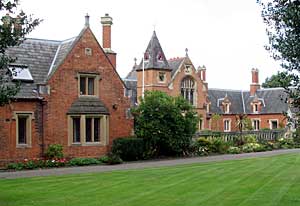
Holy Trinity Hospital, West Retford.
Jean Nicholson has a pre-Christmas offer for her new book, A Godly Inheritance, which is the history of the Holy and Undivided Trinity Hospital at West Retford and of the Denman family. Jean's offer is for the book at £7.50 plus p&p direct from her at 38, Green Lane, Lambley, Nottingham, NG4 4QE or by phone at 0115-931-2998. The book can be collected from her at Thoroton autumn meetings.
It will also be on sale at Trinity Hospital on 11 September when the hospital is open for the heritage week end. The normal price of the book is £10.50.
Call for trustees
The United Charities of Abel Collin is a 300 year old charity providing homes for people of modest means who are aged over 60 years and able to live independently.
The Charity has a five-acre site in Beeston, Nottingham, consisting of 62 houses and bungalows which can accommodate up to 100 people. A full-time warden lives on the site. The Collin's Homes is a friendly, supportive community and arranges many social activities throughout the year.
The current body of voluntary trustees has a diverse range of knowledge and experience, but there is a need for additional volunteers to expand this further. The Charity is seeking new trustees with knowledge and experience in local authority operation, the care and social services sector, accounting and budgeting, property management, the legal profession and information technology.
Trustees meet eight mornings each year to discuss plans, risks, property maintenance and development and management.
Further information by telephoning the Administrator, Mrs. Janice Avery on weekday mornings 0115-922-4826 or by email at: abelcollinsadmin@btconnect.com.
THOROTON SOCIETY WEBSITE ARCHIVED FOR POSTERITY
The Thoroton Society and Nottinghamshire Heritage Gateway websites have recently been invited to join the British Library's UK Web Archive project which is designed to 'collect, preserve and give permanent access to key UK websites for future generations', In practice this will mean that a regular snapshot of the websites will be taken every six months, the pages archived to the British Library's secure digital repository ('designed to enable the UK to preserve and make accessible its digital output forever'!) and then made available for researchers in the future.
The UK Web Archive can be found at: www.webarchive.org.uk/okwa/
THE GEDLING TOWN BOOK
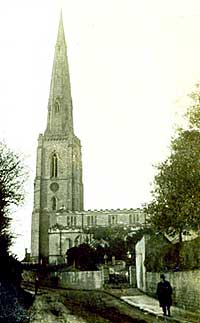
Gedling church in 1905.
The long-awaited next volume in the Society's Record Series (volume 45) is expected to be published in September. Entitled Village Government and Taxation in Later Stuart Nottinghamshire: The Gedling Town Book', 1664-1714, it has been edited by Thoroton member Ted White with a foreword by Professor Martyn Bennett of Nottingham Trent University.
The volume contains transcripts of the unusually complete financial accounts of the constables, churchwardens and overseers of the poor of Gedling which were recorded in a single manuscript volume called the Town Book'. These provide insight into the actual working of local government at village level at this period, the process of raising both local and national taxation, and farming and village life in general.
The extensive introduction by Ted White analyses the accounts to show how an ordinary English parish coped with the day-to-day demands of raising taxes for such matters as church repairs, policing, relieving the poor, and national wars. As well as being of interest to local historians in Nottinghamshire, it is thus an exemplary study which will be of value to parish historians throughout the country.
Over 200 pages long, the volume contains numerous tables, maps and illustrations. It will, of course, be free to subscribers to the Record Series and will be available to members of the main Society at a discount; at present the price has not yet been decided.
Adrian Henstock
BBC - HANDS ON HISTORY
History is a major priority on the BBC over the next two years and to compliment the programmes, BBC Learning is launching Hands on History. The aim is to work closely with partners in the heritage and community sectors to inspire families and communities to explore their histories.
The campaign launches in August with a 'Norman' season and the second phase with the working title of High Street History is due to start in late October -supporting a major BBC One TV series. The series follows families running a range of shops in a typical British High Street that has been 'taken back in time' to different eras between 1870 and 1970.
The BBC would like museums, libraries, archives, local history societies and any related organisations or groups to take part in the campaign and to build on the enthusiasm generated by the TV series.
The TV series is being filmed by the same company which makes Who Do You Think You Are? And is hoped to do for community history what WDYTYA has done for family history.
A designated week of activities is planned for late November in the East Midlands. Heritage Lottery funding might be available to support specific projects stimulated by the TV series.
Any interested parties can contact Helen Sykes, the BBC Learning Project Manager for the East Midlands at BBC East Midlands, London Road, Nottingham, NG2 4UU, 0115-902-1895 email: helen.sykes@bbc.co.uk from Tuesday to Friday each week.
BEAR JUGS and ALE MUGS: A FURTHER NOTE
By John Wilson
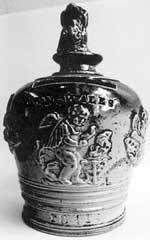

The article in the previous issue of the Newsletter under this title reminded me that one of the items on display in the exhibition at the Castle Museum belonged to my great-grandmother and was donated to the museum by my father in 1954.
The piece is a salt-glazed stoneware money box, inscribed ANN WALES 1841.
The name is almost certainly an error, possibly by the potter who made the money box, as the family name is actually WALE.
The money box is some 15cm high and has four scenes of cherubs, possibly representing the four seasons. That immediately below the name bears a striking resemblance to a cherub figure found on
Wedgewood pottery from the previous century. The box is topped by a charming figure of a small dog.
Ann Wale was the daughter of Joseph Wale and his wife Hannah Kennewell. They lived in the village of Blidworth, Nottinghamshire, where Joseph was the village wheelwright. Joseph appeared to have been reasonably prosperous. In 1841, he had a workshop and two apprentices in Blidworth, and by 1851 he also employed a foreman. Thus, there was enough money to have made for his daughter an item which was probably quite expensive. However, things started to go wrong, as by 1856 there was a petition for bankruptcy in the London Gazette in the name of Joseph Wale, wheelwright of Blidworth. We have no information on the causes of the bankruptcy. Ann, the eldest daughter, seems to have escaped the family's then poverty by marrying John Hunt in 1858. John was at various times recorded as a corn merchant, coal merchant and farm labourer.
Joseph and his family left Blidworth for Sheffield where he found work. He is thought eventually to have put his wheelwright skills to use as a railway carriage builder.
John Hunt was born in Basford, Nottingham in 1824. He moved to Blidworth and there met and married Ann Wale John and Ann had a daughter, Sarah Ann, in 1864, at which time it appears that John was working for the Walker family who owned Forge Mill between Hucknall and Papplewick. Sarah Ann's birth certificate shows her place of birth as at Forge Mill presumably in one of the mill cottages.
Sarah Ann Hunt (known as Annie in the family) married John Malpass Wilson in 1891. My father, Albert Victor Wilson, was born to them in 1896. He donated the money box to the Castle Museum in 1954.
My thanks to Pamela Wood of the Castle Museum for permission to photograph the money box.
The photographs were supplied by John. The originals are in colour and as a consequence of the change to monochrome some detail of the pottery has been lost. Rd.
THE BRITISH PATHE ARCHIVE
British Pathe is one of the oldest names in the motion picture industry having been established in London in 1902 after the company was founded by Charles Pathe in the 1890s in Paris with the company trademark of the cockerel, the French national emblem. The company produced newsreels until 1970 and has accumulated a rich assortment of historical film footage.
The archive material is now being organised following its open access on-line and counties like Nottinghamshire need the attention of knowledgeable local people to provide information to the archive.
Nottinghamshire at present has 75 videos online which can be accessed at:
www.britishpathe.com/workspace.php?id=5334&display=list
As the Archive's knowledge of the area is limited they have only been able to search place names as keywords but many villages and smaller towns would not have been written down in the canister notes by the cameramen at the time of filming. The Archive, therefore, hopes that local people will view the films and if they can identify landmarks, establishments, notable figures or special events it will help to identify more videos specific to Nottinghamshire.
There are 90,000 old reels on the main website at http://www.britishpathe.com/ so a browse of these might produce some unidentified as yet local material.
Further information can be obtained from Jack Cullen, Media Officer, British Pathe Ltd., The Media Centre, 3-8, Carburton Street, London, W1W 5AJ or by email: notts@britishpathe.com.
LESSONS FROM THE PAST: READING, WRITING AND ARITHMETIC IN THE UNIVERSITY OF NOTTINGHAM HISTORIC COLLECTIONS
A new exhibition by the University of Nottingham's Manuscripts and Special Collections Department will be showing at the Weston Gallery, D. H. Lawrence Pavilion, Lakeside, University Park from 10 September to 19 December.
The subject of the exhibition is the teaching of basic education over the centuries, and the ways in which children were helped along the path to literacy. Drawing heavily on the Brigg's Collection of Educational Literature, it features some of the early tools for learning the alphabet, the primers and spelling books intended for young children, and also some of the recreational reading books and games that were available Children's exercise books showing their progress in writing and arithmetic can be seen, and examples of fine penmanship are also displayed.
Levels of schooling for young children varied enormously, with some getting none at all, and others having rudimentary schooling in free schools, or local village schools. Privileged children from wealthy homes such as Clumber Hall or Welbeck Abbey, had governesses to teach them at home. Snippets from the collections give an insight into the experience of school, focusing mostly on the 18th and 19th centuries. D. H. Lawrence's experiences of school, both as pupil and teacher, are touched on, and visitors will be bale to see one of his school text-books. Documents relating to schools in Mansfield, Greasley and Cuckney will be on display, as are records from High Pavement Sunday School.
A series of lunchtime talks will be held to accompany the exhibition but places need to be booked in advance. Furhter information is available on the Manuscripts Department website.